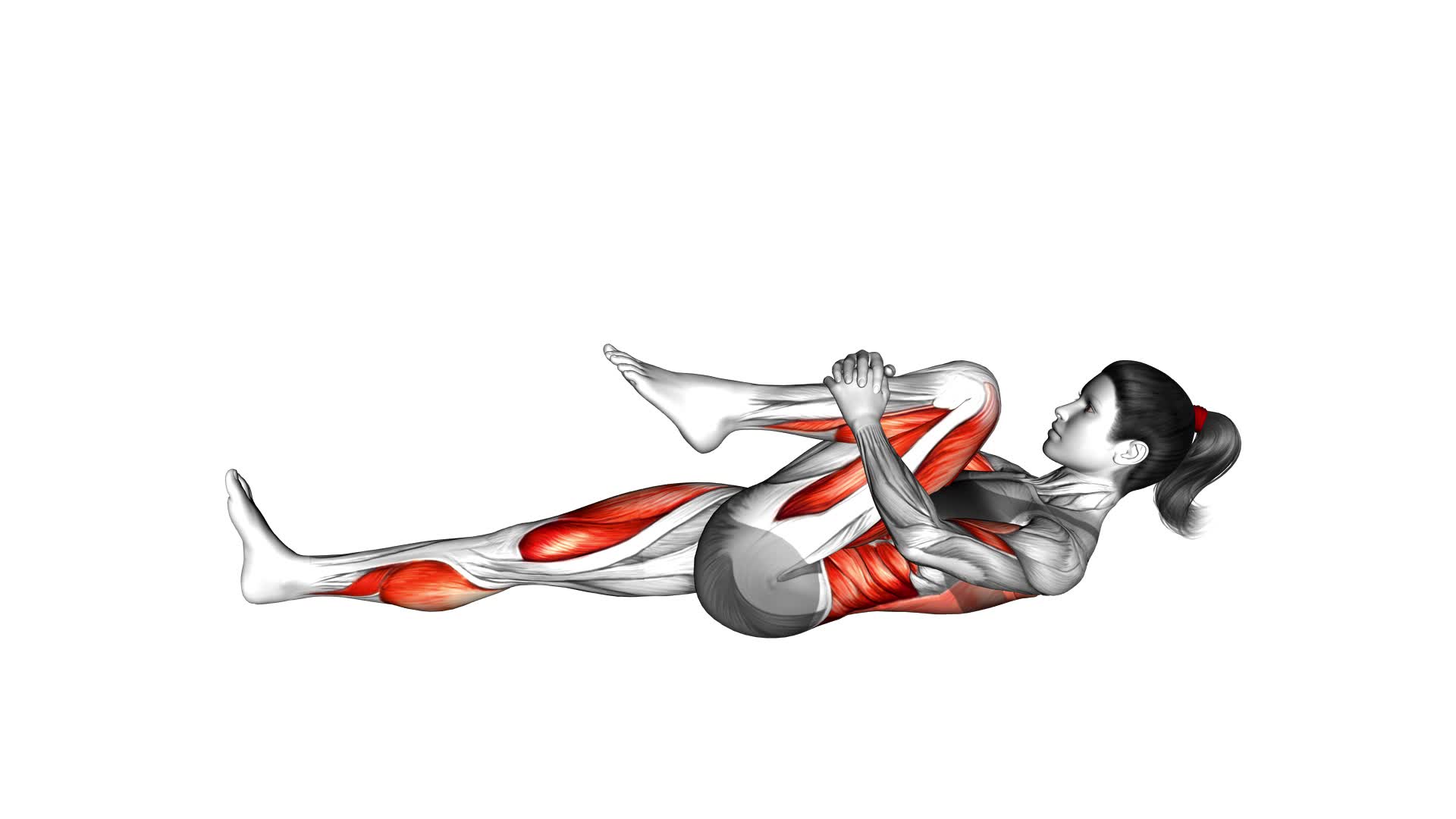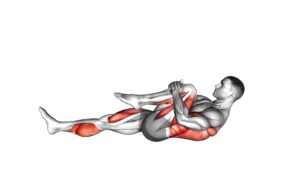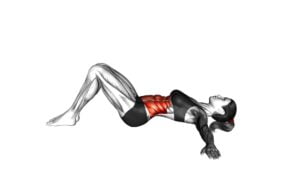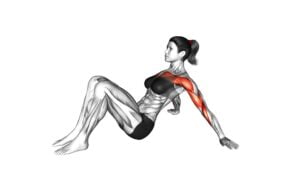Single Leg Stretch (Bent Knee) (Female) – Video Exercise Guide & Tips

Get ready to strengthen and tone your legs with the Single Leg Stretch (Bent Knee) exercise.
Watch This Exercise Video
In this video exercise guide, we'll show you the proper form and technique to maximize your results. You'll also find helpful tips and modifications to suit your fitness level.
Avoid common mistakes and get the most out of this exercise with our expert advice.
Let's dive in and start working those legs!
Key Takeaways
- Single Leg Stretch (Bent Knee) exercise strengthens and tones the legs while targeting the abdominal muscles.
- Proper form and technique are crucial to maximize the benefits and prevent injuries during the exercise.
- Incorporating proper breathing techniques enhances oxygen flow, stamina, and overall performance.
- Modifications and progressions can be made to increase the challenge and adapt the exercise to different fitness levels.
Benefits of Single Leg Stretch (Bent Knee) Exercise
Experience the numerous benefits of the Single Leg Stretch (Bent Knee) exercise to strengthen your core and improve flexibility. This exercise primarily targets your abdominal muscles, particularly the rectus abdominis and the obliques. By engaging these muscles, you can develop a stronger and more stable core, which can improve your posture and overall body alignment. Additionally, the Single Leg Stretch (Bent Knee) exercise helps to increase your hip and hamstring flexibility, allowing for better range of motion in daily activities and other exercises.
To perform this exercise with proper form and technique, start by lying on your back with your knees bent and your feet flat on the floor. Lift one leg off the ground, keeping your knee bent at a 90-degree angle. As you exhale, hug the lifted knee towards your chest while simultaneously lifting your head and shoulders off the ground. Inhale as you switch legs, extending one leg out while bringing the other knee towards your chest. Repeat this movement in a controlled and smooth manner, keeping your core engaged throughout the exercise.
Remember to maintain proper alignment by keeping your lower back pressed into the floor and avoiding any excessive arching or rounding of the spine. Keep your movements controlled and avoid using momentum to perform the exercise.
Proper Form and Technique for Single Leg Stretch (Bent Knee)
To perform the Single Leg Stretch (Bent Knee) exercise with proper form and technique, you should start by lying on your back with your knees bent and your feet flat on the floor. Place your hands behind your head, keeping your elbows wide. Engage your core muscles by pressing your lower back into the floor.
As you inhale, lift your head, neck, and shoulders off the floor. Exhale as you extend your right leg straight out and bring your left knee towards your chest. Hold this position for a moment, feeling the stretch in your hamstrings and engaging your abdominal muscles.
Inhale again and switch legs, extending the left leg out while bringing the right knee towards your chest. Repeat this motion for the desired number of repetitions, focusing on your breath and maintaining control throughout the movement.
Incorporating proper breathing techniques into the Single Leg Stretch (Bent Knee) exercise helps to oxygenate your muscles and increase your overall stamina.
To incorporate the Single Leg Stretch (Bent Knee) into a sample workout routine, you can perform 2-3 sets of 10-12 repetitions on each leg, alternating sides. Remember to listen to your body and adjust the intensity as needed.
Now that you have a good understanding of the proper form and technique for the Single Leg Stretch (Bent Knee) exercise, let's explore some modifications and progressions to challenge yourself even further.
Modifications and Progressions for Single Leg Stretch (Bent Knee)
Try adding resistance by using a resistance band or ankle weights during the Single Leg Stretch (Bent Knee) exercise. This will help to increase the intensity and challenge your muscles even more. Start by placing the resistance band around your ankles and hold onto the ends with your hands. As you perform the exercise, focus on maintaining proper form and control. The resistance from the band will engage your muscles in a different way, targeting them from different angles. This modification is great for those looking to take their Single Leg Stretch (Bent Knee) to the next level.
To progress further, you can try extending your legs fully instead of keeping them bent. This variation, known as the Single Leg Stretch (Straight Leg), increases the difficulty of the exercise by requiring more strength and stability. Make sure to keep your core engaged and your lower back pressed into the mat throughout the movement.
Another progression is to increase the speed of the exercise. By performing the Single Leg Stretch (Bent Knee) at a faster pace, you'll challenge your muscles to work harder and improve your cardiovascular endurance. However, it's important to maintain control and avoid sacrificing form for speed.
Remember to listen to your body and start with modifications that suit your current fitness level. As you become stronger and more comfortable, you can gradually progress to more challenging variations.
Common Mistakes to Avoid During Single Leg Stretch (Bent Knee)
To avoid common mistakes during the Single Leg Stretch (Bent Knee), focus on maintaining proper alignment and engaging your core. One common mistake is failing to keep your spine in a neutral position. Avoid rounding or arching your back, as this can strain your neck and lower back.
Another mistake isn't engaging your core muscles throughout the exercise. Keep your abdominal muscles tight to stabilize your torso and protect your lower back. It's also important to avoid using momentum to move your legs. Instead, focus on controlled movements and maintain a steady pace.
Another mistake to watch out for is lifting your head too high. Keep your head and neck relaxed, with your gaze directed towards your abdominals. This will help prevent strain on your neck and allow for proper breathing. Lastly, avoid gripping your neck or shoulders with your hands. Instead, lightly support your head with your fingertips, allowing your neck and shoulders to stay relaxed.
Tips for Getting the Most Out of Single Leg Stretch (Bent Knee)
To get the most out of the Single Leg Stretch (Bent Knee) exercise, it's important to focus on two key aspects: proper form techniques and breathing techniques.
Maintaining proper form throughout the exercise ensures that you're targeting the correct muscles and maximizing the effectiveness of the movement. This means keeping your core engaged and your spine in a neutral position. It's important to avoid any excessive arching or rounding of the back, as this can put strain on the spine and take away from the intended benefits of the exercise.
Additionally, practicing proper breathing techniques can greatly enhance the overall benefits of the Single Leg Stretch. As you perform the exercise, focus on inhaling deeply during the stretch phase, when you extend your leg away from your body. Then, exhale fully during the contraction phase, when you bring your knee back towards your chest. This controlled breathing helps to engage the core muscles and promotes better oxygen flow throughout the body.
Proper Form Techniques
To maximize the benefits of the Single Leg Stretch (Bent Knee) exercise, ensure that you maintain proper form throughout the movement. Proper form is crucial as it allows you to target the right muscles, prevent injuries, and get the most out of your workout.
By keeping your core engaged and your back flat on the floor, you can effectively engage your abdominal muscles and strengthen your core.
It's important to also focus on your breathing, inhaling deeply as you bring your knee towards your chest and exhaling as you extend your leg.
Breathing Techniques During Exercise
As you continue with the Single Leg Stretch (Bent Knee) exercise, focus on your breathing to maximize the benefits and get the most out of your workout. Proper breathing techniques can greatly enhance your performance and help you achieve your fitness goals.
Here are some tips to help you optimize your breathing during this exercise:
- Take deep breaths: Inhale deeply through your nose and exhale fully through your mouth. This will help oxygenate your muscles and release any tension.
- Coordinate your breath with your movements: Inhale as you prepare for the movement and exhale as you engage your core and extend your legs.
- Maintain a steady rhythm: Consistent and controlled breathing will help you maintain your focus and energy throughout the exercise.
By incorporating these breathing techniques, you can improve your endurance, increase your oxygen intake, and enhance your overall performance during the Single Leg Stretch (Bent Knee) exercise.
With a solid foundation in breathing, you're now ready to move on to a sample workout routine incorporating this exercise.
Sample Workout Routine Incorporating Single Leg Stretch (Bent Knee)
Start your workout routine by incorporating the single leg stretch (bent knee) exercise. This exercise is a great way to engage multiple muscles while improving core strength and flexibility. To add variety to your workout, you can try different variations of the single leg stretch.
For example, you can perform the exercise with a resistance band around your feet or use ankle weights to increase the intensity. These variations will challenge your muscles in different ways, promoting further muscle engagement and growth.
To begin the exercise, lie on your back with your knees bent and feet flat on the floor. Lift one leg off the ground and bring your knee towards your chest, holding onto your shin or ankle. Extend your other leg straight out in front of you. Inhale as you switch legs, bringing the opposite leg towards your chest while extending the other leg. Exhale as you switch again, continuing this alternating motion for a set number of repetitions or a specific amount of time.
Incorporating the single leg stretch (bent knee) exercise into your workout routine will help strengthen your core, improve flexibility, and engage multiple muscle groups. Remember to listen to your body and adjust the difficulty level as needed.
Frequently Asked Questions
How Many Repetitions Should I Do for the Single Leg Stretch (Bent Knee) Exercise?
For the single leg stretch (bent knee) exercise, the recommended number of repetitions depends on your fitness level and goals. Start with 10 to 12 repetitions per set and gradually increase as you get stronger.
Remember to listen to your body and adjust accordingly. There are also variations of the single leg stretch that you can incorporate into your routine to challenge different muscle groups and keep your workouts interesting.
Can I Perform the Single Leg Stretch (Bent Knee) Exercise if I Have Knee Pain?
If you have knee pain, it's important to listen to your body. Performing the single leg stretch (bent knee) exercise may aggravate your condition. It's recommended to avoid exercises that cause discomfort or pain.
Instead, focus on modifications that are gentler on the knees. Consult with a healthcare professional or a certified trainer who can provide you with alternative exercises or modifications that will help you work your core without straining your knees.
Is It Necessary to Use a Mat or Can I Perform the Single Leg Stretch (Bent Knee) Exercise on a Hard Surface?
To perform the single leg stretch (bent knee) exercise on a hard surface, it's recommended to use a mat for added comfort and support. However, if you don't have a mat, you can still do the exercise.
Just make sure to modify it based on your knee pain. Listen to your body and avoid any movements that cause discomfort.
Should I Perform the Single Leg Stretch (Bent Knee) Exercise Before or After My Cardio Workout?
Performing single leg stretches (bent knee) before or after your cardio workout depends on your preference and fitness goals. Before your cardio, it can help warm up your muscles and prepare your body for the intense exercise.
After your cardio, it can provide a good stretch and help with recovery. Beginners can modify the single leg stretch (bent knee) exercise by keeping the non-working leg on the ground and gradually increasing the range of motion as they get stronger.
Can I Incorporate Other Exercises With the Single Leg Stretch (Bent Knee) Exercise for a More Challenging Workout?
To make your workout more challenging, you can incorporate other exercises with the single leg stretch (bent knee) exercise. Try adding weights to increase resistance and build strength.
You can also modify the exercise by extending your legs fully or by adding a twist to engage different muscles. Remember to maintain proper form and listen to your body to avoid injury.
Consult a professional trainer for personalized advice and guidance.
Conclusion
In conclusion, the single leg stretch (bent knee) exercise is a beneficial way to strengthen the core and improve flexibility. By maintaining proper form and technique, avoiding common mistakes, and incorporating modifications and progressions, you can maximize the effectiveness of this exercise.
Remember to listen to your body, start slowly, and gradually increase intensity. Incorporating the single leg stretch (bent knee) into your workout routine can help you achieve your fitness goals.

Author
Years ago, the spark of my life’s passion ignited in my mind the moment I stepped into the local gym for the first time. The inaugural bead of perspiration, the initial endeavor, the very first surge of endorphins, and a sense of pride that washed over me post-workout marked the beginning of my deep-seated interest in strength sports, fitness, and sports nutrition. This very curiosity blossomed rapidly into a profound fascination, propelling me to earn a Master’s degree in Physical Education from the Academy of Physical Education in Krakow, followed by a Sports Manager diploma from the Jagiellonian University. My journey of growth led me to gain more specialized qualifications, such as being a certified personal trainer with a focus on sports dietetics, a lifeguard, and an instructor for wellness and corrective gymnastics. Theoretical knowledge paired seamlessly with practical experience, reinforcing my belief that the transformation of individuals under my guidance was also a reflection of my personal growth. This belief holds true even today. Each day, I strive to push the boundaries and explore new realms. These realms gently elevate me to greater heights. The unique combination of passion for my field and the continuous quest for growth fuels my drive to break new ground.







